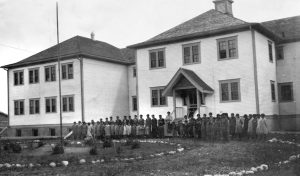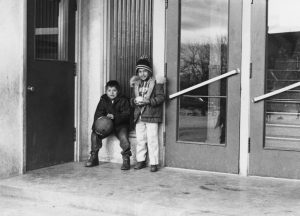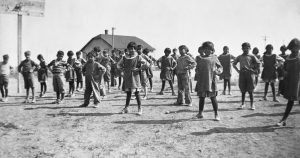Indigenous Education Before and After Colonization
Enjoy video Indigenous Education Before and After Colonization with transcript.
Please be mindful: This page contains information about Residential Schools. This information may be painful and difficult to view. It is a deeply troubling part of the story of education in Canada.
A National Indian Residential School Crisis Line has been set up to provide support for former Residential School students. You can access emotional and crisis referral services by calling 24-Hour National Crisis Line: 1-866-925-4419
—
Education for the Shortgrass Prairie’s first residents was much different than for the settlers of Beiseker. Nitsitapii (Blackfoot) education was integrated into the fabric of everyday life. Children were not sent to school. They were taught by their loved ones around them as adults went about the business of taking care of community needs. The Nitsitapii teaching style had sustained generations of children, teaching them all they needed to know for life on this land.
Missionaries set about changing the world of the Nitsitapii
The impacts of missionaries and the church representatives on Indigenous people cannot be understated; they left a complex and devastating legacy across this land which is still being experienced and negotiated today. At best, Indian Residential Schools (IRS) were set up to separate children from their community and culture in an attempt to assimilate them. Many survivors of the schools refer to these places as hellscapes of abuse and neglect. Education was largely limited to prayer and hard labor, as it was felt these would serve Indigenous children better than academics.
Meaningful understanding of the Nitsitapii experience of residential schools can be found in their own words. Adrian suggests Arthur Bear Chief’s My Decade at Old Sun: My Lifetime in Hell, which the author has provided online in order for Canadians to better understand this legacy. Adrian also recommends the testimonial and archival work available at Remembering the Children website. He suggests caution and consideration when approaching the topic of residential schools.
“Even things we see as being positive from our viewpoint might be horrendous triggers for others, because we don’t know what happened to them. But we can be there for them, we can support them, we can love them and let them know that they’re valuable.”
Adrian Wolfleg
Today Indigenous children on the prairies study the same curriculum as non-Indigenous children. Efforts are being made to rectify the residential school period through investment in language and cultural programming, as well as teaching the truth of what happened on this land to children of all backgrounds. Adrian has fond memories of studying and working in schools alongside Indigenous and non-Indigenous colleagues, celebrating holidays, playing sports, and building relationships and community together.




